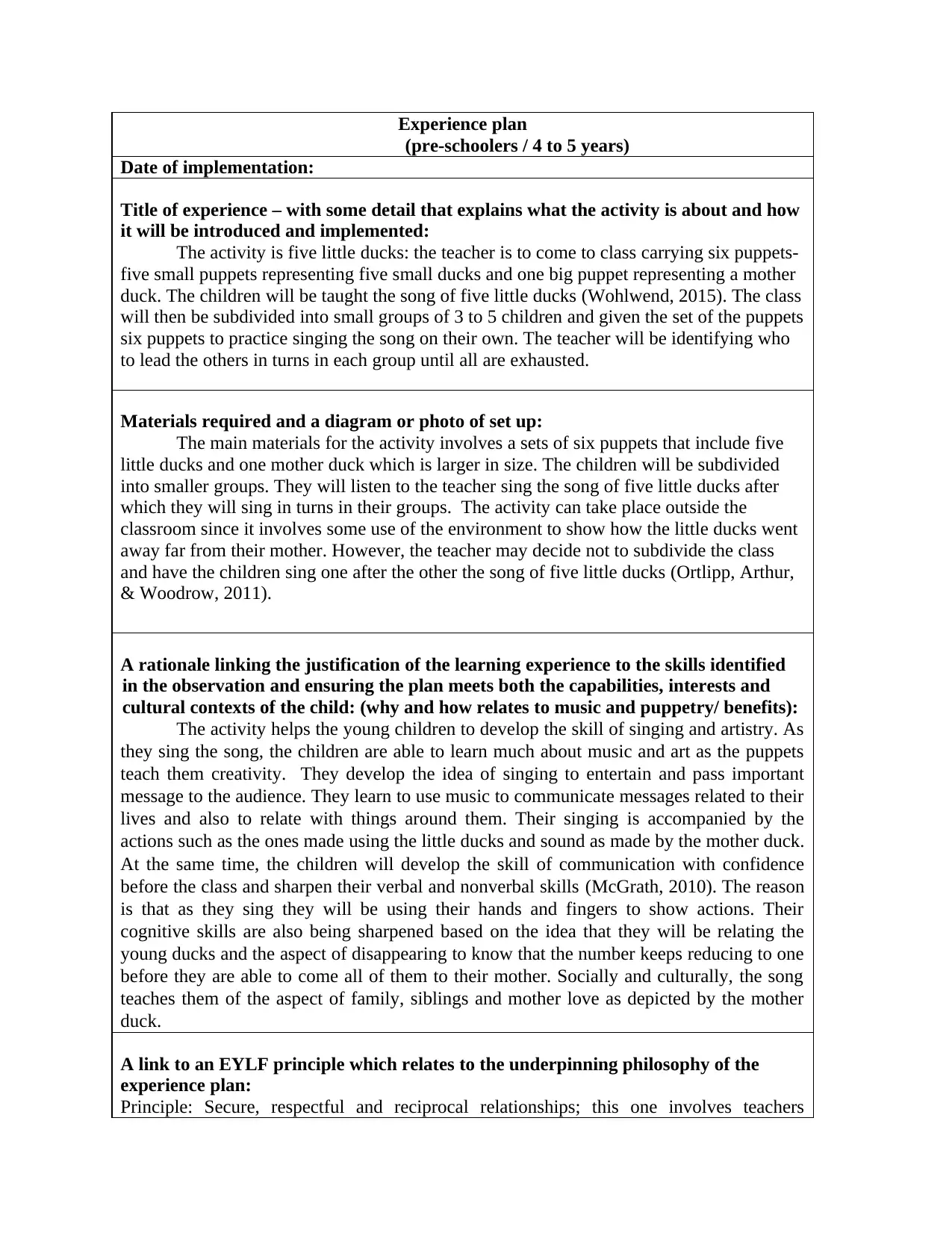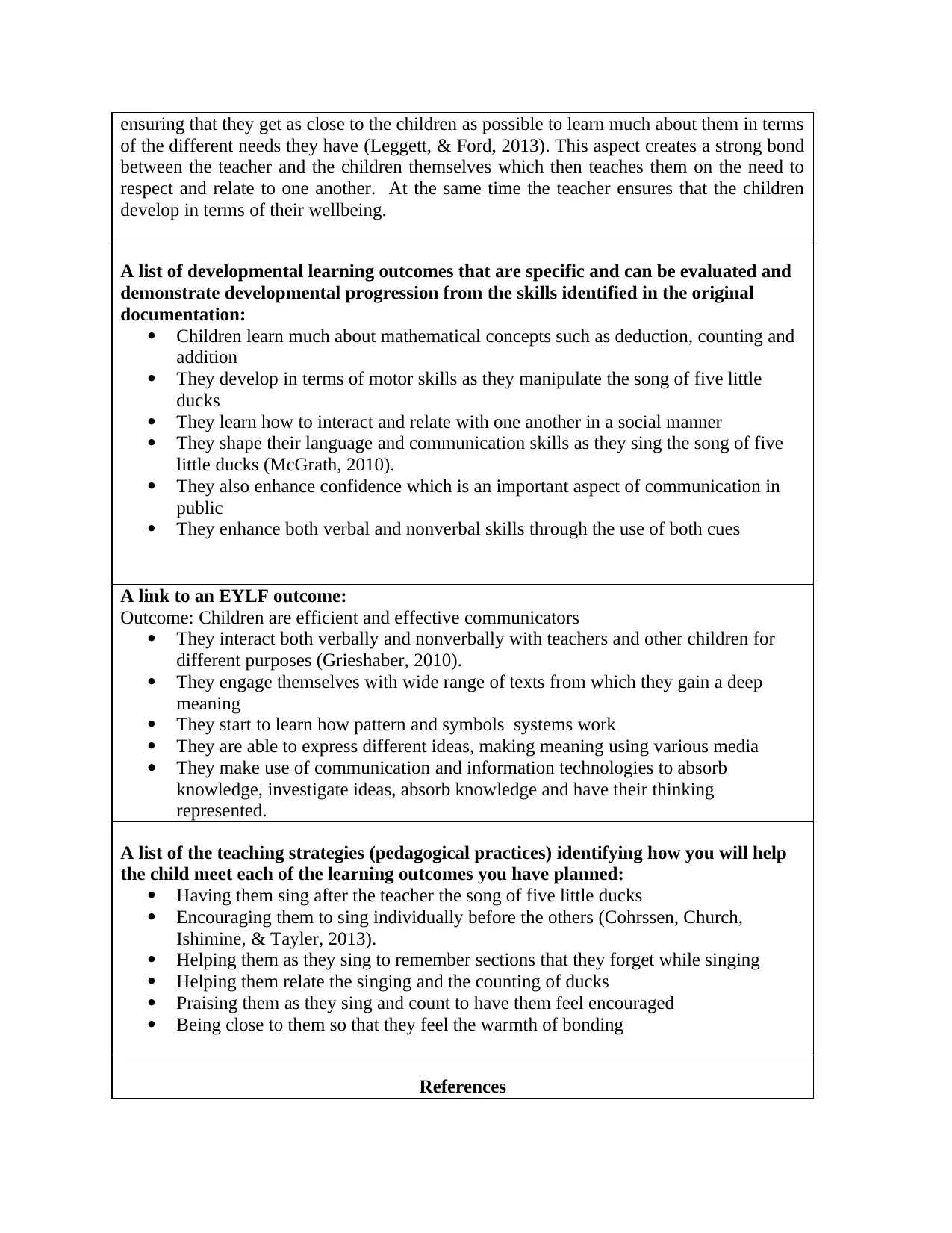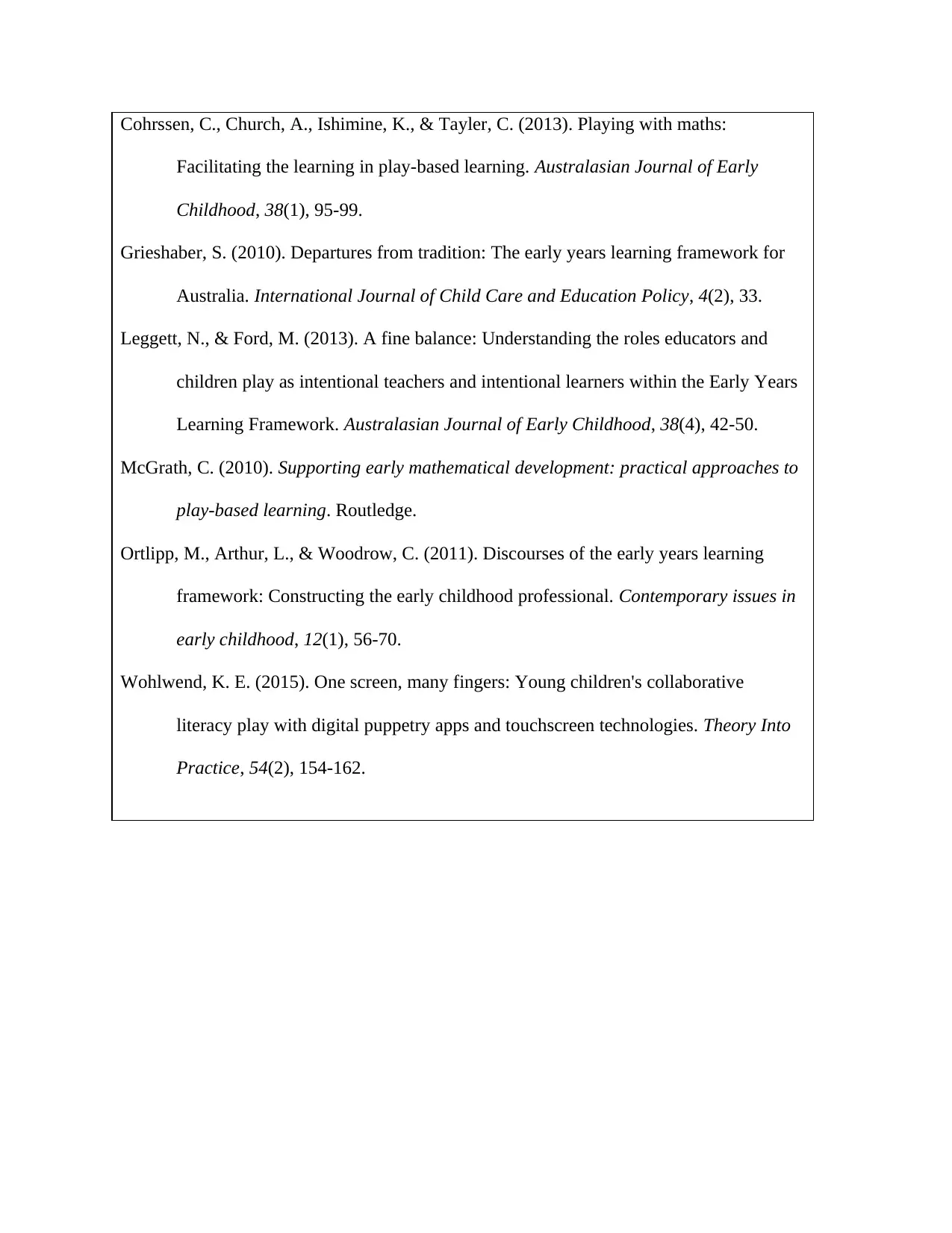Experience Plan: Five Little Ducks Song for Preschoolers (4-5 years)
VerifiedAdded on 2022/10/17
|3
|1201
|98
Practical Assignment
AI Summary
This document details an experience plan designed for preschool children aged 4-5, centered around the song 'Five Little Ducks.' The activity involves using puppets to enact the song, encouraging singing, counting, and motor skill development. The plan includes a rationale linking the activity to learning outcomes, focusing on music, art, and communication skills. The activity is linked to the EYLF principles of secure relationships and respectful interactions. The developmental learning outcomes include mathematical concepts, motor skills, social interaction, and language development. The teaching strategies involve having children sing, encouraging individual participation, and providing positive reinforcement. The plan aims to enhance children's communication, cognitive, and social-emotional development, using a fun and engaging approach with puppets and music to foster a strong connection between the children and the teacher.

Experience plan
(pre-schoolers / 4 to 5 years)
Date of implementation:
Title of experience – with some detail that explains what the activity is about and how
it will be introduced and implemented:
The activity is five little ducks: the teacher is to come to class carrying six puppets-
five small puppets representing five small ducks and one big puppet representing a mother
duck. The children will be taught the song of five little ducks (Wohlwend, 2015). The class
will then be subdivided into small groups of 3 to 5 children and given the set of the puppets
six puppets to practice singing the song on their own. The teacher will be identifying who
to lead the others in turns in each group until all are exhausted.
Materials required and a diagram or photo of set up:
The main materials for the activity involves a sets of six puppets that include five
little ducks and one mother duck which is larger in size. The children will be subdivided
into smaller groups. They will listen to the teacher sing the song of five little ducks after
which they will sing in turns in their groups. The activity can take place outside the
classroom since it involves some use of the environment to show how the little ducks went
away far from their mother. However, the teacher may decide not to subdivide the class
and have the children sing one after the other the song of five little ducks (Ortlipp, Arthur,
& Woodrow, 2011).
A rationale linking the justification of the learning experience to the skills identified
in the observation and ensuring the plan meets both the capabilities, interests and
cultural contexts of the child: (why and how relates to music and puppetry/ benefits):
The activity helps the young children to develop the skill of singing and artistry. As
they sing the song, the children are able to learn much about music and art as the puppets
teach them creativity. They develop the idea of singing to entertain and pass important
message to the audience. They learn to use music to communicate messages related to their
lives and also to relate with things around them. Their singing is accompanied by the
actions such as the ones made using the little ducks and sound as made by the mother duck.
At the same time, the children will develop the skill of communication with confidence
before the class and sharpen their verbal and nonverbal skills (McGrath, 2010). The reason
is that as they sing they will be using their hands and fingers to show actions. Their
cognitive skills are also being sharpened based on the idea that they will be relating the
young ducks and the aspect of disappearing to know that the number keeps reducing to one
before they are able to come all of them to their mother. Socially and culturally, the song
teaches them of the aspect of family, siblings and mother love as depicted by the mother
duck.
A link to an EYLF principle which relates to the underpinning philosophy of the
experience plan:
Principle: Secure, respectful and reciprocal relationships; this one involves teachers
(pre-schoolers / 4 to 5 years)
Date of implementation:
Title of experience – with some detail that explains what the activity is about and how
it will be introduced and implemented:
The activity is five little ducks: the teacher is to come to class carrying six puppets-
five small puppets representing five small ducks and one big puppet representing a mother
duck. The children will be taught the song of five little ducks (Wohlwend, 2015). The class
will then be subdivided into small groups of 3 to 5 children and given the set of the puppets
six puppets to practice singing the song on their own. The teacher will be identifying who
to lead the others in turns in each group until all are exhausted.
Materials required and a diagram or photo of set up:
The main materials for the activity involves a sets of six puppets that include five
little ducks and one mother duck which is larger in size. The children will be subdivided
into smaller groups. They will listen to the teacher sing the song of five little ducks after
which they will sing in turns in their groups. The activity can take place outside the
classroom since it involves some use of the environment to show how the little ducks went
away far from their mother. However, the teacher may decide not to subdivide the class
and have the children sing one after the other the song of five little ducks (Ortlipp, Arthur,
& Woodrow, 2011).
A rationale linking the justification of the learning experience to the skills identified
in the observation and ensuring the plan meets both the capabilities, interests and
cultural contexts of the child: (why and how relates to music and puppetry/ benefits):
The activity helps the young children to develop the skill of singing and artistry. As
they sing the song, the children are able to learn much about music and art as the puppets
teach them creativity. They develop the idea of singing to entertain and pass important
message to the audience. They learn to use music to communicate messages related to their
lives and also to relate with things around them. Their singing is accompanied by the
actions such as the ones made using the little ducks and sound as made by the mother duck.
At the same time, the children will develop the skill of communication with confidence
before the class and sharpen their verbal and nonverbal skills (McGrath, 2010). The reason
is that as they sing they will be using their hands and fingers to show actions. Their
cognitive skills are also being sharpened based on the idea that they will be relating the
young ducks and the aspect of disappearing to know that the number keeps reducing to one
before they are able to come all of them to their mother. Socially and culturally, the song
teaches them of the aspect of family, siblings and mother love as depicted by the mother
duck.
A link to an EYLF principle which relates to the underpinning philosophy of the
experience plan:
Principle: Secure, respectful and reciprocal relationships; this one involves teachers
Paraphrase This Document
Need a fresh take? Get an instant paraphrase of this document with our AI Paraphraser

ensuring that they get as close to the children as possible to learn much about them in terms
of the different needs they have (Leggett, & Ford, 2013). This aspect creates a strong bond
between the teacher and the children themselves which then teaches them on the need to
respect and relate to one another. At the same time the teacher ensures that the children
develop in terms of their wellbeing.
A list of developmental learning outcomes that are specific and can be evaluated and
demonstrate developmental progression from the skills identified in the original
documentation:
Children learn much about mathematical concepts such as deduction, counting and
addition
They develop in terms of motor skills as they manipulate the song of five little
ducks
They learn how to interact and relate with one another in a social manner
They shape their language and communication skills as they sing the song of five
little ducks (McGrath, 2010).
They also enhance confidence which is an important aspect of communication in
public
They enhance both verbal and nonverbal skills through the use of both cues
A link to an EYLF outcome:
Outcome: Children are efficient and effective communicators
They interact both verbally and nonverbally with teachers and other children for
different purposes (Grieshaber, 2010).
They engage themselves with wide range of texts from which they gain a deep
meaning
They start to learn how pattern and symbols systems work
They are able to express different ideas, making meaning using various media
They make use of communication and information technologies to absorb
knowledge, investigate ideas, absorb knowledge and have their thinking
represented.
A list of the teaching strategies (pedagogical practices) identifying how you will help
the child meet each of the learning outcomes you have planned:
Having them sing after the teacher the song of five little ducks
Encouraging them to sing individually before the others (Cohrssen, Church,
Ishimine, & Tayler, 2013).
Helping them as they sing to remember sections that they forget while singing
Helping them relate the singing and the counting of ducks
Praising them as they sing and count to have them feel encouraged
Being close to them so that they feel the warmth of bonding
References
of the different needs they have (Leggett, & Ford, 2013). This aspect creates a strong bond
between the teacher and the children themselves which then teaches them on the need to
respect and relate to one another. At the same time the teacher ensures that the children
develop in terms of their wellbeing.
A list of developmental learning outcomes that are specific and can be evaluated and
demonstrate developmental progression from the skills identified in the original
documentation:
Children learn much about mathematical concepts such as deduction, counting and
addition
They develop in terms of motor skills as they manipulate the song of five little
ducks
They learn how to interact and relate with one another in a social manner
They shape their language and communication skills as they sing the song of five
little ducks (McGrath, 2010).
They also enhance confidence which is an important aspect of communication in
public
They enhance both verbal and nonverbal skills through the use of both cues
A link to an EYLF outcome:
Outcome: Children are efficient and effective communicators
They interact both verbally and nonverbally with teachers and other children for
different purposes (Grieshaber, 2010).
They engage themselves with wide range of texts from which they gain a deep
meaning
They start to learn how pattern and symbols systems work
They are able to express different ideas, making meaning using various media
They make use of communication and information technologies to absorb
knowledge, investigate ideas, absorb knowledge and have their thinking
represented.
A list of the teaching strategies (pedagogical practices) identifying how you will help
the child meet each of the learning outcomes you have planned:
Having them sing after the teacher the song of five little ducks
Encouraging them to sing individually before the others (Cohrssen, Church,
Ishimine, & Tayler, 2013).
Helping them as they sing to remember sections that they forget while singing
Helping them relate the singing and the counting of ducks
Praising them as they sing and count to have them feel encouraged
Being close to them so that they feel the warmth of bonding
References

Cohrssen, C., Church, A., Ishimine, K., & Tayler, C. (2013). Playing with maths:
Facilitating the learning in play-based learning. Australasian Journal of Early
Childhood, 38(1), 95-99.
Grieshaber, S. (2010). Departures from tradition: The early years learning framework for
Australia. International Journal of Child Care and Education Policy, 4(2), 33.
Leggett, N., & Ford, M. (2013). A fine balance: Understanding the roles educators and
children play as intentional teachers and intentional learners within the Early Years
Learning Framework. Australasian Journal of Early Childhood, 38(4), 42-50.
McGrath, C. (2010). Supporting early mathematical development: practical approaches to
play-based learning. Routledge.
Ortlipp, M., Arthur, L., & Woodrow, C. (2011). Discourses of the early years learning
framework: Constructing the early childhood professional. Contemporary issues in
early childhood, 12(1), 56-70.
Wohlwend, K. E. (2015). One screen, many fingers: Young children's collaborative
literacy play with digital puppetry apps and touchscreen technologies. Theory Into
Practice, 54(2), 154-162.
Facilitating the learning in play-based learning. Australasian Journal of Early
Childhood, 38(1), 95-99.
Grieshaber, S. (2010). Departures from tradition: The early years learning framework for
Australia. International Journal of Child Care and Education Policy, 4(2), 33.
Leggett, N., & Ford, M. (2013). A fine balance: Understanding the roles educators and
children play as intentional teachers and intentional learners within the Early Years
Learning Framework. Australasian Journal of Early Childhood, 38(4), 42-50.
McGrath, C. (2010). Supporting early mathematical development: practical approaches to
play-based learning. Routledge.
Ortlipp, M., Arthur, L., & Woodrow, C. (2011). Discourses of the early years learning
framework: Constructing the early childhood professional. Contemporary issues in
early childhood, 12(1), 56-70.
Wohlwend, K. E. (2015). One screen, many fingers: Young children's collaborative
literacy play with digital puppetry apps and touchscreen technologies. Theory Into
Practice, 54(2), 154-162.
⊘ This is a preview!⊘
Do you want full access?
Subscribe today to unlock all pages.

Trusted by 1+ million students worldwide
1 out of 3
Related Documents
Your All-in-One AI-Powered Toolkit for Academic Success.
+13062052269
info@desklib.com
Available 24*7 on WhatsApp / Email
![[object Object]](/_next/static/media/star-bottom.7253800d.svg)
Unlock your academic potential
Copyright © 2020–2025 A2Z Services. All Rights Reserved. Developed and managed by ZUCOL.





